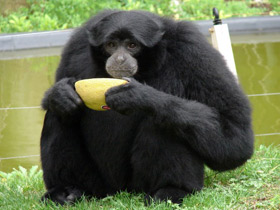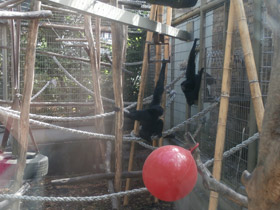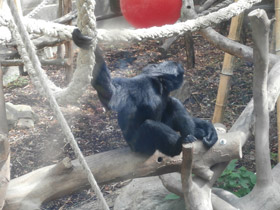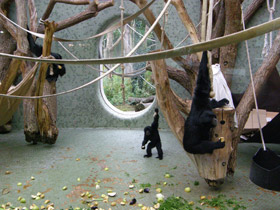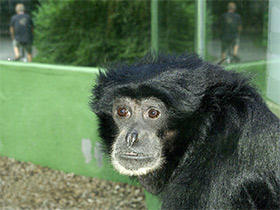The siamang (Symphalangus syndactylus o Hylobates syndactylus)
Siamang видео
The siamang (/ˈsiːəmæŋ/, also UK: /ˈsaɪə-/; Symphalangus syndactylus) is an arboreal, black-furred gibbon native to the forests of Indonesia, Malaysia, and Thailand. The largest of the gibbons, the siamang can be twice the size of other gibbons, reaching 1 m (3.3 ft) in height, and weighing up to 14 kg (31 lb). It is the only species in the genus Symphalangus. Fossils of siamangs date back to the Middle Pleistocene.
Two features distinguish the siamang from other gibbons. First, two digits on each foot—the second and third toes—are partially joined by a membrane, hence the specific name syndactylus, from the Ancient Greek σύν, sun-, "with" + δάκτυλος, daktulos, "finger". Second, a large gular sac (throat pouch), found in both males and females of the species, can be inflated to the size of the siamang's head, allowing it to make resonating calls.
Two subspecies of the siamang are the nominate Sumatran siamang (Symphalangus syndactylus syndactylus) and the Malaysian siamang (Symphalangus syndactylus continentis, in Malay peninsula). Otherwise, the Malaysian individuals are only a population. The siamang occurs sympatrically with other gibbons; its two ranges are entirely within the combined ranges of the agile gibbon and the lar gibbon.
The siamang can live to around 40 years in captivity.
While the illegal pet trade takes a toll on wild populations, the principal threat to the siamang is habitat loss in both Indonesia and Malaysia. The palm oil production industry is clearing large swaths of forest, reducing the habitat of the siamang, along with those of other species, such as the Sumatran tiger.
Descripción y distribución
Symphalangus syndactylus es una especie de primate hominoideo de la familia Hylobatidae. El siamang es la única especie en el género Symphalangus.
El Symphalangus syndactylus es el más grande y pesado de los gibones. Tiene una longitud corporal de 75-90 cm y un peso de 8-13 kg, con una envergadura de brazos de hasta 1,5 m. Los siamangs viven en el sur de la península malaya y en Sumatra.
Particularidades y reproducción
Estos monos tienen una bolsa en la garganta muy desarrollada que les sirve de resonador cuando cantan, por lo que el canto del Symphalangus syndactylus puede oírse a 3-4 kilómetros de distancia. La bolsa de la garganta de las hembras y los machos está siempre desnuda. A diferencia de otros gibones, el Symphalangus syndactylus nada muy bien. Tras una gestación de siete meses, la hembra de Symphalangus syndactylus da a luz a una cría y la alimenta con leche durante unos dos años. Los jóvenes de Symphalangus syndactylus alcanzan la madurez sexual aproximadamente a los seis o siete años de edad.
Dieta
El siamang se alimenta principalmente de diversas partes de plantas. El siamang de Sumatra es más frugívoro que su pariente malayo, y la fruta constituye hasta el 60% de su dieta. Come al menos 160 especies de plantas, desde enredaderas hasta plantas leñosas. Su principal fuente de alimento son los higos (Ficus spp.). El siamang prefiere comer fruta madura a inmadura, y hojas jóvenes a viejas. Come flores y algunos animales, sobre todo insectos. Cuando come flores grandes, sólo se come las corolas (pétalos), pero se come todas las partes de las flores más pequeñas, y los frutos pequeños los recoge en la mano antes de consumirlos. Cuando come semillas grandes y duras o con bordes afilados, pela la pulpa del fruto y tira la semilla. Aunque su dieta consiste en porciones sustanciales de fruta, es el más folívoro de todos los miembros de Hylobatidae. Como también es el gibón más grande, encaja bien con la tendencia dietética general de los primates, según la cual los primates más grandes tienden a ser más folívoros.
Role of calling
The siamang starts its day by calling in the early morning; it calls less after midday, with the peak of the calls around 9:00 to 10:00 am. Most of the siamang's calls are directed to its neighbours rather than to those inside its home range. This means the siamang's calling is in response to disturbances and to defend its territory. Calls in the late morning typically happen when it meets or sees another siamang group. The edge of the siamang's home range, which may overlap another, is often the place where calling is made. Counter (co-response) calling occasionally happens near the border or in the overlap area. Calls are numerous when fruit is more abundant rather than when it is less available. Branch shaking, swinging, and moving around the tree crowns accompany the calling. This movement might be to show the other groups where they are.
The siamang prefers calling in the living, tall, and big trees, possibly where another group is easy to see. Besides that, such trees can support siamang movement. Calling trees are usually near feeding trees, but sometimes they call in the feeding trees.
Mated pairs produce loud, well-patterned calling bouts, which are referred to as duetting. These calls advertise the presence and status of a mated pair. Newly formed pairs spend more time singing than an established pair. Advertising the presence of a strong bond is advantageous in territorial defense. Siamang duetting differs from other species because it has a particularly complex vocal structure. Four distinct classes of vocalizations have been documented: booms, barks, ululating screams, and bitonal screams. Females typically produce long barks and males generally produce bitonal screams, but both sexes have been known to produce all four classes of vocalizations.
Seeding
As a frugivorous animal, the siamang disperses seeds through defecation as it travels across its territory. The siamang can carry seed while digesting, and defecate between 81.9 and 365.9 m (269 and 1,200 ft) from the seed resource, which supports the forest's regeneration and succession.
Threats and conservation
As an arboreal primate whose survival absolutely depends on the forest, the siamang faces population pressure due to habitat loss, poaching, and hunting.
Habitat loss
A major threat to the siamang is habitat fragmentation due to plantations, forest fire, illegal logging, encroachment, and human development. Firstly, palm-oil plantations have removed large areas of the siamang's habitat in recent decades. Since 2002, 107,000 km2 of oil palm have been planted, which has replaced much rainforest in Indonesia and Malaysia, where the siamang originally lived. Secondly, in the second decade of the 21st century, forests in the Malay peninsula have been destroyed due to illegal logging. Sixteen out of the 37 permanent forest reserves in Kelantan, in the Malay peninsula, where most of the siamangs live, have been encroached upon by illegal loggers. Thirdly, forest encroachments change forest cover into cultivated land; for example, the rising price of coffee in 1998 encouraged people in Sumatra to replace the forest with coffee plantations. Fourthly, development in many areas requires infrastructure, such as roads, which now divide conservation areas and have caused forest fragmentation and edge effects.
Poaching and hunting
Unlike other parts of Asia, primates are not hunted for their meat in Indonesia. They are hunted for the illegal pet trade, with hunters preferring infant siamangs. Poachers often kill the mothers first, since siamang females are highly protective of their infants, and removing the infant without first killing the mother requires more effort. Most siamangs on the market are infants, which often die during transportation.
Conservation
Siamang can be found in at least 11 protected areas:
Indonesia:
- Bukit Barisan Selatan National Park;
- Gunung Leuser National Park;
- Kerinci Seblat National Park;
- Langkat Barat Wildlife Reserve;
- Way Kambas National Park;
Malaysia:
- Fraser's Hill Reserve;
- Gunong Besout Forest Reserve;
- Krau Wildlife Reserve;
- Ulu Gombak Wildlife Reserve;
Thailand:
- Hala Bala Wildlife Sanctuary.

















